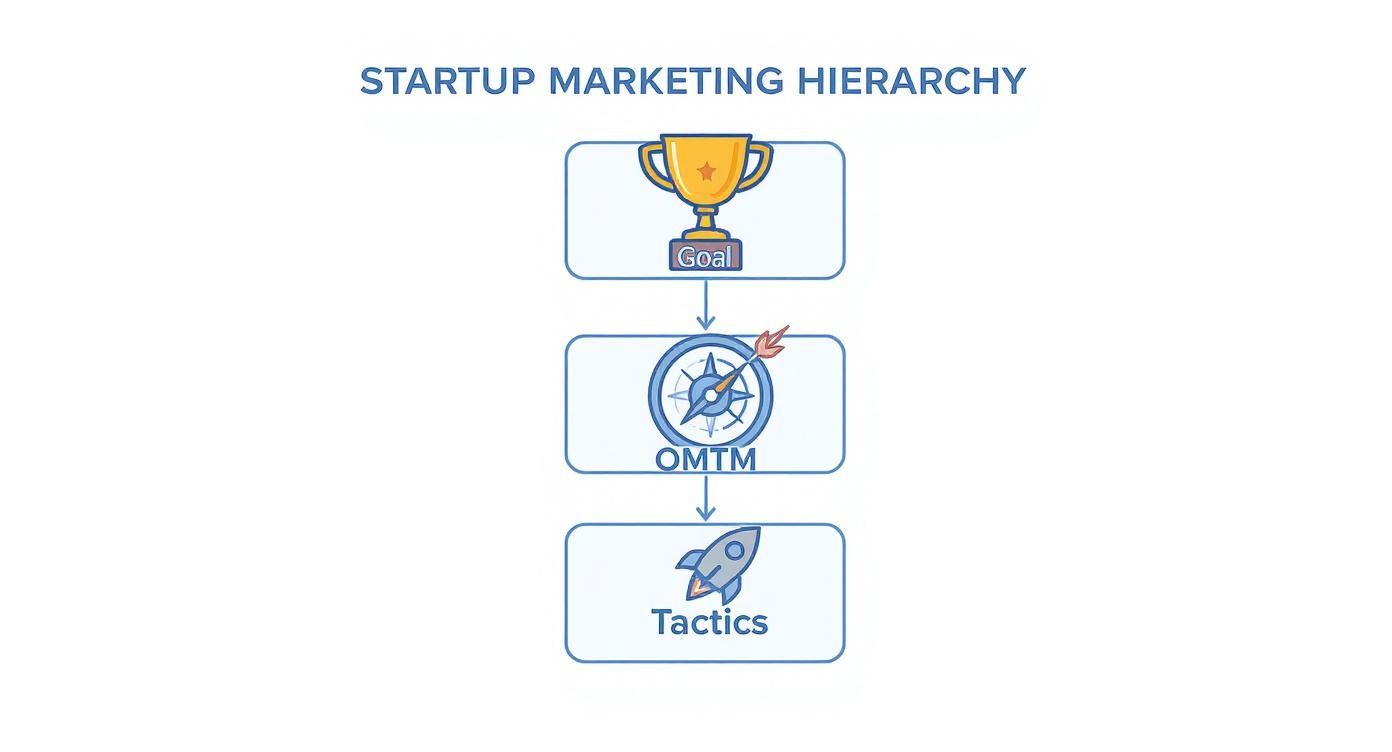
Forget the dense textbooks. A solid marketing strategy for a startup is a compass, not a map. It's a lean, founder-led plan that connects every dollar spent and every hour worked to one core goal. This isn't about sprawling spreadsheets; it's about ruthless prioritization on a single, measurable objective.
The No-Nonsense Startup Marketing Framework
As a founder, you're short on two things: money and time. Your marketing strategy can't be a theoretical exercise. At BillyBuzz, we don't chase vanity metrics. Every decision gets filtered through one question: does this move the needle on our One Metric That Matters (OMTM)?
Your OMTM is your north star—Monthly Recurring Revenue (MRR), Daily Active Users (DAU), whatever. Picking one forces clarity and stops you from spreading efforts too thin.
This focus is non-negotiable. Poor marketing isn't just a missed opportunity; it’s a direct path to failure. In fact, roughly 14% of startups fail simply because of bad marketing, which really highlights why a focused plan is so critical.
Define Your Compass: The OMTM
Before you build a strategy, define what winning looks like. Your OMTM aligns your entire team around a single goal. It turns abstract ideas into concrete actions.
This simple hierarchy shows how your main business goal directly informs your OMTM, which in turn dictates the tactics you execute on the ground.

As you can see, effective startup marketing isn't random. It flows logically from a high-level goal all the way down to specific, actionable tactics, making sure every ounce of effort has a purpose.
To help you put this into practice, we've broken down these core ideas into a simple canvas.
The Lean Startup Marketing Canvas
Here's a quick summary of the core components of our startup marketing strategy, designed for fast reference and even faster implementation.
| Component | What It Means For You | Example Action Item |
|---|---|---|
| Business Goal | The ultimate objective you're trying to achieve (e.g., profitability). | Reach $1M in Annual Recurring Revenue (ARR). |
| OMTM | The single metric that best represents progress toward your goal. | Increase new Monthly Recurring Revenue (MRR) by 15% month-over-month. |
| Target Audience | A laser-focused profile of your ideal customer. | B2B SaaS founders in the FinTech space with teams of 10-50. |
| Marketing Channels | The specific platforms where you'll reach your audience. | LinkedIn content, targeted cold email outreach, and niche community forums. |
| Tactical Execution | The concrete actions you'll take on those channels. | Publish one in-depth case study on LinkedIn per week. |
This canvas acts as a one-page-plan to keep your entire team aligned and focused on what truly matters.
Building Your Founder-Led Engine
Once your OMTM is locked in, build a repeatable system to influence it. This is where being a founder gives you a massive advantage. No one understands your product and customer pain better than you.
Your initial strategy should be built around tactics that play to this strength. Get directly involved in niche online communities. Create content that answers specific user questions.
A founder-led marketing strategy isn’t about a huge budget. It’s about deep customer empathy and using it to find scalable, high-leverage growth channels that competitors overlook.
For a deeper dive into laying the groundwork for your startup's growth, this essential guide on marketing for small business is a great resource for exploring those foundational concepts.
Ultimately, this framework isn’t about doing everything; it’s about doing the right things, relentlessly.
How We Found Our First 100 Customers on Reddit
Forget big-budget ads. Your first hundred customers are already talking about the problems your startup solves. The challenge isn't shouting louder; it's listening smarter. This is exactly how we built our initial user base at BillyBuzz—by turning online conversations into our primary user acquisition channel.
The secret is a simple mindset shift: move from brand monitoring to problem monitoring. Instead of just tracking your company name, track the specific words people use when they describe their frustrations. This pivot puts you right in front of people actively hunting for a solution.
Setting Up Our Listening Posts
To do this without spending all day scrolling, we built a system. We use automated alerts as digital scouts. You don’t need a fancy enterprise tool.
Here are the exact keyword alerts we set up in F5Bot to find potential BillyBuzz customers on Reddit. Each one is designed to catch someone expressing a specific need.
("how to find customers on reddit" OR "get users from reddit")("find mentions of my brand" OR "track keywords on reddit")("competitor OR brand name" AND alternative)(saas OR startup) AND ("customer acquisition" OR "user feedback")
These are digital tripwires. The moment someone posts using one of these phrases, we get a ping. This lets us jump into the conversation while it's fresh.
Our High-Value Community Filters
Not all communities are equal. Focus where your ideal customers gather and are genuinely looking for help. We lock in on specific subreddits where founders and marketers swap stories and ask for advice.
This screenshot from r/startups shows the kind of high-intent conversations that pop up every single day.

A thread titled "How are you getting your first 10 paying customers?" is pure gold. It’s a perfect opening to step in and offer real, actionable help.
Here’s our go-to subreddit list:
- /r/startups: The classic hub for founders sharing wins, losses, and growth questions.
- /r/saas: A niche community for deep dives into SaaS models, metrics, and marketing.
- /r/marketing: A broader forum, great for finding discussions about specific marketing pain points.
- /r/growmybusiness: Where entrepreneurs actively seek advice they can use today.
Trust me, focusing on a handful of high-quality communities is way more effective than trying to be everywhere at once.
The Response Template We Use to Engage
So your alert fires. How you respond is everything. The goal is to be helpful, not loud. A blatant sales pitch gets you ignored. Add genuine value first.
We use a simple framework called the Value-First Template.
1. Acknowledge and Validate: "That's a tough spot. Finding those first users feels like a huge mountain to climb."
2. Offer Actionable Advice (No Strings Attached): "One thing that worked for us was setting up keyword alerts for competitor mentions. It helped us find people already looking for a solution."
3. Soft-Pitch with Context: "We actually built a tool to automate this because manual searching was eating up all our time. It might be useful for what you’re trying to do."
This positions you as a helpful expert, not a spammer. It builds trust and encourages people to learn more on their own terms, which is how you win your first 100 fiercely loyal customers.
Building a Content Engine on a Bootstrapped Budget
https://www.youtube.com/embed/qCAKH9SaWnc
Forget the idea that "content marketing" requires a massive operation. As a founder, you don't have a full-time writing team. Good. You don't need one.
Building a lean content engine on a bootstrapped budget is possible with a smarter, more disciplined approach.
At BillyBuzz, we run our entire content operation on the ‘Pillar and Spoke’ model. We start with one major, in-depth guide—like this one—and treat it as our "pillar." This becomes the single source of truth from which we create dozens of smaller, bite-sized "spoke" assets. One pillar post can be repurposed into social media threads, email newsletters, and short-form video scripts.
This method is about working smarter, not harder. You create a consistent stream of valuable content without starting from scratch every time. It's the ultimate hack for founders who need to punch above their weight.
Finding Keywords That Actually Convert
Here's the hard truth: your content is useless if no one finds it. That's why solid keyword research is the absolute foundation of our pillar content.
We don't chase vanity keywords with massive search volume. Instead, we hunt for high-intent, low-competition keywords. These are the phrases people type in when they’re past "just browsing" and are actively looking for a solution.
Think about "what is marketing" versus "social listening tool for Reddit." That second searcher is much closer to a decision. Our process is simple:
- Brainstorm Problem-Aware Keywords: We list the specific problems our customers face, like "how to find customers on Reddit" or "track brand mentions online."
- Analyze Search Intent: We plug those keywords into Google and see what ranks. Blog posts? Product pages? Forum threads? This tells us what Google thinks users want. You can learn more about turning these discussions into SEO gold in our guide on how Reddit posts now rank on Google.
- Find the "Goldilocks Zone": Using SEO tools, we look for keywords with just enough search volume to be worthwhile, but not so much that we’re competing against huge corporations. That’s our sweet spot.
This focused approach ensures every piece of pillar content is engineered to attract an audience that is ready and willing to listen.
The Power of Video in Your Strategy
While written content is our pillar, video is often our most effective spoke. It’s simply the fastest way to build an emotional connection and establish yourself as a trusted voice in your space.
Video has become a non-negotiable part of modern marketing. An impressive 89% of businesses are already using it, and 68% of those who aren't plan to jump in within the next year. Videos are fantastic at appealing to human emotion—something many brands struggle with—which helps boost both engagement and conversions.
As a founder, you are your startup's best storyteller. Video lets you speak directly to your audience, explain complex ideas simply, and put a human face to your brand. Don't overthink production—your iPhone and a simple script are all you need to start.
By combining a strong pillar of written content with engaging video spokes, you create a self-sustaining content engine. This system works around the clock to drive traffic, build authority, and nurture leads, all without needing a massive budget or a dedicated team.
Finding Growth in Niche Communities
Big platforms like LinkedIn or Facebook Ads are pay-to-play jungles—crowded and expensive. Your real advantage as a founder isn't a massive budget; it's agility. It's your ability to go where big brands won't: into small, hyper-engaged niche communities.

In private Slack channels, Discord servers, and niche forums, your ideal customers are already gathered. They're asking for advice and actively looking for solutions. A smart marketing strategy for a startup is to become a trusted voice in these spaces, not just another advertiser. The mission is to build relationships, not chase clicks.
Becoming a Valued Community Member
Joining is easy. Earning your place is the real work. The number one rule: give more than you take. Before you even think about mentioning your product, build a reputation as a helpful expert.
At BillyBuzz, we follow a simple internal checklist:
- Listen First: Spend the first week just reading. Get a feel for the culture and unwritten rules.
- Answer Questions: Look for threads where you can offer real expertise, even if it has nothing to do with your product.
- Share Resources: Post helpful links to articles, tools, or other resources.
- Engage Authentically: Comment on others' posts, offer encouragement, and be an active participant.
Only after building this social capital can you subtly introduce what you're working on, always as a solution to a problem being discussed. For a masterclass on this exact approach, check out our detailed guide on how to get customers from Reddit in 2025.
Our Micro-Influencer Marketing Playbook
Another powerful channel is micro-influencer marketing. I’m not talking about celebrities. I'm talking about respected practitioners with small, highly engaged audiences who hang on their every word. A single, genuine mention from the right person is more impactful than a massive ad campaign.
The influencer marketing industry is absolutely booming and is projected to hit an astounding $32.55 billion globally by 2025. This explosive growth gives startups a direct line to authentic engagement, but it also means you have to be smart about your partners. Digging into these startup platform marketing statistics can help you see where the opportunities are.
Our approach is built on genuine partnership, not transactional placements.
We don’t pay for posts. We build relationships with smart people whose work we admire, offer them free access to our tool, and let them decide if it’s valuable enough to share with their audience. It’s authentic, and it works.
Here is the exact outreach template we use. It’s short, founder-to-founder, and focuses on mutual value.
Subject: Big fan of your work on [Platform]
Hey [Influencer Name],
My name is [Your Name], founder of BillyBuzz. Been following your [newsletter/channel] and loved your recent piece on [Specific Topic]. The way you explained [Concept] was spot on.
I built a tool that helps founders find customers on Reddit. Based on your content, I thought it might be genuinely useful for you and your audience.
No strings attached, but I'd be happy to set you up with a free lifetime account if you're open to checking it out.
Either way, keep up the amazing work.
Best,
[Your Name]
This low-pressure, high-respect approach shows you value their time, leading to authentic collaborations that drive real results.
How to Automate Marketing Without Losing Your Soul
As a founder, your time is your most precious asset. Automation is a survival tactic.
But there’s a trap: automating relationships instead of processes. At BillyBuzz, we live by a simple rule: automate the machine, not the conversation. This lets us scale our marketing efforts while never losing the human touch.
The point is to clone your efficiency, not your personality. Good automation takes on repetitive tasks, freeing you up to talk to customers.
If you’re just getting started, a solid small business guide to marketing automation can be a great resource for using technology to grow faster without sacrificing that all-important personal connection.
Our Behind-the-Scenes Automation Stack
You don't need a massive tech stack. We lean on a handful of user-friendly tools that save us dozens of hours every month.
- F5Bot for Social Listening: Our digital scout. It scans Reddit for our keywords and pings us in Slack the moment it finds something, turning a tedious manual search into a hands-off notification system.
- Slack for Triage: Our command center. All alerts funnel into dedicated Slack channels, where we quickly assess which conversations need a human response.
- Zapier as the Glue: Our digital duct tape. Zapier connects our apps and triggers actions without writing a single line of code.
These three tools are the backbone of our system, allowing a tiny team to have the impact of a much larger one.
The Alert Rule That Saves Our Sanity
Here is one of the exact workflows we use every day at BillyBuzz that you can set up yourself.
The High-Intent Lead Filter
This workflow automatically sorts through online chatter to flag high-value conversations on Reddit, ensuring we never miss a chance to connect with a potential customer.
- Trigger: F5Bot finds a keyword match in a relevant subreddit (like r/saas) and posts an alert to our
#reddit-mentionschannel in Slack. - Filter: A Zapier filter instantly scans the post for high-intent keywords like "competitor," "alternative," or "recommendation."
- Action: If it finds a match, Zapier automatically adds a 🔥 emoji reaction to the Slack message and tags me directly. I know it’s a high-priority conversation that needs my personal attention.
This simple automation turns a stream of noise into a curated list of high-intent leads. It makes sure my time is spent on conversations that actually move the needle, not on sifting through irrelevant mentions.
Notice what’s happening here. We automate the discovery of the lead, but the engagement is always 100% human. It’s the perfect blend of efficiency and authenticity—a cornerstone of any smart startup marketing strategy.
Measuring What Actually Matters for Growth
Social media likes feel good, but they don't pay the bills. In startups, every marketing dollar has to pull its weight. It's easy to get fooled by "vanity metrics"—numbers that look good but create an illusion of progress while your runway shrinks.
A solid marketing strategy for a startup has to be built on cold, hard, actionable data.

At BillyBuzz, we cut through the noise with a simple dashboard that tracks just a few core metrics. These numbers tell the true story of our business health and guide every move we make. It’s what turns our marketing from a guessing game into a predictable, profit-generating engine.
Our Three Essential Growth Metrics
Forget sprawling spreadsheets. To get started, you just need to monitor the vital signs of your startup. These are the three metrics we live and breathe.
Customer Acquisition Cost (CAC): How much does it cost you in sales and marketing to get one new paying customer? This is the ultimate report card for your marketing efficiency.
Lifetime Value (LTV): What is the total revenue you can reasonably expect from a single customer? This tells you what a customer is actually worth.
Conversion Rate: The percentage of people who take the action you want, like signing up for a trial. It shows how well you’re turning lookers into buyers.
The relationship between these three is everything. The golden rule is simple: your LTV must be significantly higher than your CAC. Aim for an LTV:CAC ratio of 3:1 or better. If you spend $100 to get a customer who only ever pays you $50, you have a leaky bucket, not a business.
From Vanity to Actionable Metrics
It’s easy to get distracted by numbers that look impressive but mean nothing for your bottom line. We’ve learned to be ruthless about filtering our data.
This table breaks down how we think about it.
Startup Metrics: Vanity vs. Actionable
| Metric Category | Avoid This Vanity Metric | Track This Actionable Metric Instead | Why It Matters |
|---|---|---|---|
| User Engagement | Total Page Views | Trial-to-Paid Conversion Rate | Tells you if users find enough value to actually pay you. |
| Social Media | Follower Count | Clicks-to-Signup Rate from Social | Measures if social media is driving real business, not just eyeballs. |
| Content | Blog Traffic Volume | Leads Generated per Blog Post | Connects content creation directly to customer acquisition. |
Vanity metrics tell you how many people see your stuff; actionable metrics tell you how many of them care enough to act.
A successful marketing strategy for a startup isn't about getting the most attention; it's about getting the right attention from people who will eventually pay you. This simple shift in focus is a game-changer.
Focusing on actionable metrics creates a powerful feedback loop. Is your CAC too high? Rethink your channels. Are conversion rates lagging? Overhaul the landing page.
If you're struggling to make this connection, our guide on measuring social media ROI can help you tie your efforts to real business outcomes. This data-driven approach removes the guesswork, allowing you to invest your limited time and money with confidence.
Startup Marketing FAQ
As a founder, you're wearing a dozen hats, and "marketing expert" is one you have to put on fast. Here are straight answers to the most common questions we hear from other founders.
How Much Should a Startup Spend on Marketing?
Forget the old rules. Spending 5-12% of revenue is useless when you have no revenue.
Instead, think in terms of Customer Acquisition Cost (CAC). Figure out a customer's lifetime value (LTV), then work backward to set a target CAC. If you can spend $50 to acquire a customer, your budget becomes simple math: how many customers do you want this month? Multiply by $50, and there's your budget. This ties every dollar spent to a business goal.
When Should I Hire My First Marketer?
Hire your first marketer the moment you, the founder, have found a repeatable customer acquisition channel.
You have to be your own first marketer. There’s no way around it. Doing it yourself forces you to get painfully close to your customers and truly understand what makes them tick.
Hiring someone before you've figured this out is a classic mistake. They'll burn through your cash trying to find something that works. Your first marketing hire isn't there to discover your growth playbook; they're there to take the one you've already proven and scale it.
What Is the Most Common Early-Stage Marketing Mistake?
The biggest mistake is trying to be everywhere at once. Founders get FOMO, see competitors on every platform, and feel they need to be there too. This is a recipe for disaster.
You spread your tiny budget and limited time so thin you make no dent anywhere. It’s far more effective to pick one or two channels where your ideal customers hang out and go incredibly deep. Own a subreddit. Become the expert in a niche Slack group. Win on one channel first, and win big. That’s infinitely better than being a ghost on ten.
Ready to master one of the most powerful channels for startup growth? BillyBuzz uses AI to find you new customers on Reddit, delivering high-intent leads directly to your Slack or email so you can engage at the perfect moment. Start finding your next customers today.
